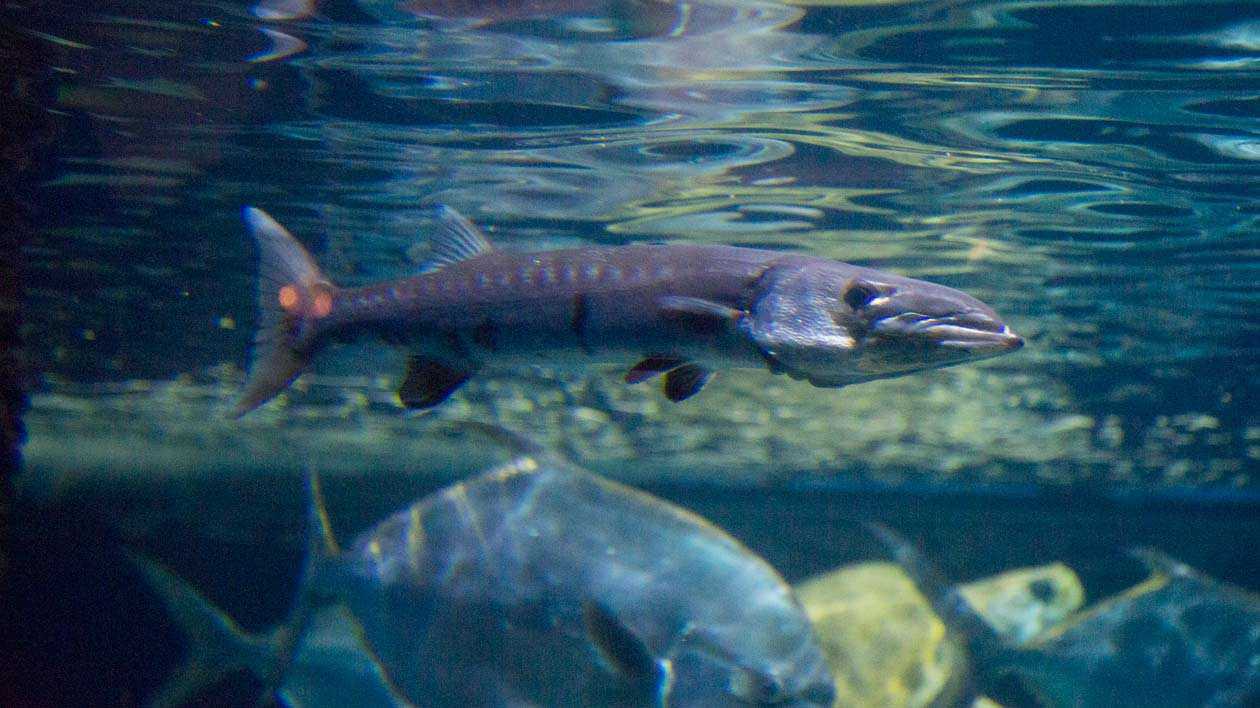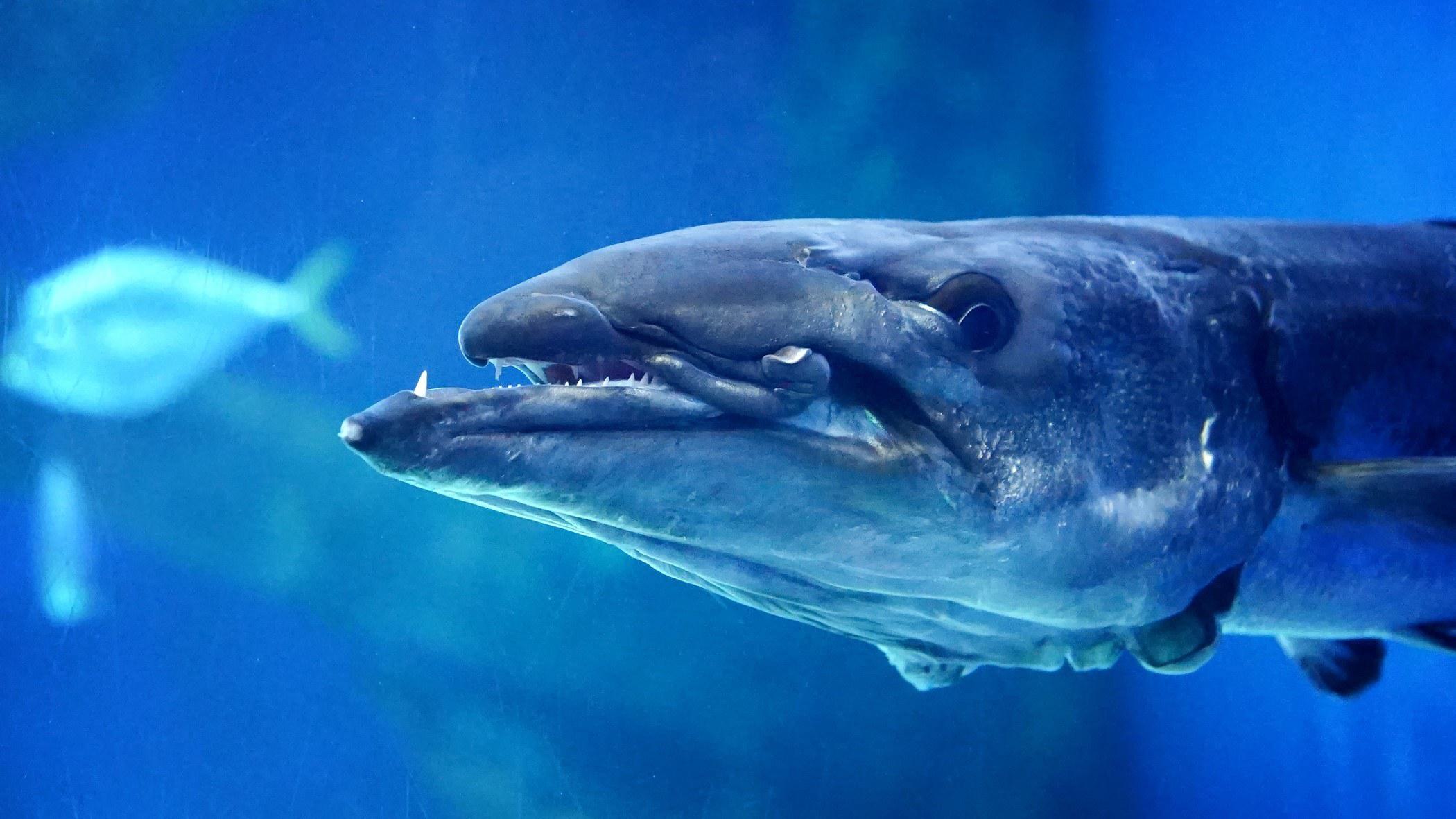Length: Up to 5 feet.
Weight: Close to 100 pounds.
The great barracuda is the largest of the 26 species of barracuda. They can be found in blue, green, or brown colorations that transition into a silvery color on the sides and a creamy white on the belly. Young barracuda have a dark stripe that runs the length of the fish's body. As it grows, this stripe breaks into dark blotchy areas or vertical bars. The great barracuda has unique black spots on the lower sides that distinguish it from other barracuda species.
This species has a large mouth with a long lower jaw protruding past the upper jaw, as well as a mouth filled with dozens of razor-sharp teeth. These teeth grow in two rows: an outer row of small, sharp teeth for tearing flesh, and an inner row of longer knife-like teeth for grasping prey.
Diet
Great barracudas are top predators and opportunistic feeders. They will eat a variety of fish throughout the water column, including species such as grunts, groupers, snappers, small tunas, herrings, and other prey like shrimp and cephalopods. Barracudas can open their mouths very wide to feed on their larger prey. Evidence suggests that barracudas hunt more by sight than by smell.
Habitat
Most species of barracuda live in near-shore habitats, such as seagrass beds, mangroves, and coral reefs. Great barracuda inhabit marine tropical and sub-tropical waters of the Mediterranean Sea, the Western Atlantic, Pacific, and Indian Oceans, and the Caribbean. They prefer submerged reefs, coral heads, coastal lagoons, and the deeper water of the open ocean, living near the surface.
Mobility
This fish is capable of swimming up to 35 mph and is one of the fastest animals in the ocean. However, they cannot maintain high speeds over long distances and instead rely on short bursts of speed when hunting. Most of their time is spent swimming slowly, conserving energy for eventual ambushes upon their prey.
Reproduction
Though spawning behaviors are not well-documented, scientists believe that mating takes place in deeper, offshore waters in spring. However, the season may span from April to September, when the water is warmer. Females release between 5,000 and 30,000 eggs that are then fertilized by the male in open waters before being dispersed by currents. This process might be repeated several times during a breeding season.
Newly hatched barracuda fry (babies) settle in shallow estuaries where they hide in and feed on vegetation until they grow to about two inches in length. At this time, the fry tend to remain in mangrove and seagrass habitats until they reach one year of age. Juvenile barracudas can change color to better camouflage themselves from predators.
Males reach sexual maturity by three years of age, but females usually require a year longer for maturity. During the second year of life, they move to deep reef areas where they will spend their adulthood.
Relationship with Humans
Unprovoked barracuda attacks on humans are rare, though great barracudas are inquisitive and often drawn to shiny objects such as jewelry - as a result, accidental bites do occur. If a barracuda bites a human, it usually releases the human upon realizing they are not a prey fish. Though barracuda bites are rarely fatal, damage often requires medical attention and stitches.
Ciguatera Fish Poisoning
Ciguatera fish poisoning can cause severe symptoms ranging from digestive issues to physiological problems like headaches, muscle pain, and even heart problems and fluctuation in blood pressure. While smaller barracuda are considered generally "safe" to consume, consuming larger ones is highly discouraged and illegal in the United States. This is because adult barracuda have ingested more of the herbivorous reef fish that eat a toxic plankton known as Gambiendiscus toxicus, which attaches itself to algae on the coral reef.
Concerns
The primary predators of barracuda are killer whales, sharks, and dolphins. Other concerns that may impact barracuda populations are ocean acidification and loss of coral reefs, seagrass beds, and mangroves. They can also get entangled in fishing nets where overfishing is practiced, and accidental sea vessel collisions can also cause death. Fishing of barracuda is regulated in the United States.
Celebrations
Populations of great barracuda have remained stable, and conservationists do not consider the species to be endangered or threatened. At one time barracuda were hunted as a human food source prior to public awareness of the risk of ciguatera food poisoning. Barracuda therefore are not often hunted for food, though they are considered a sporting challenge for recreational deep-sea fishers.



